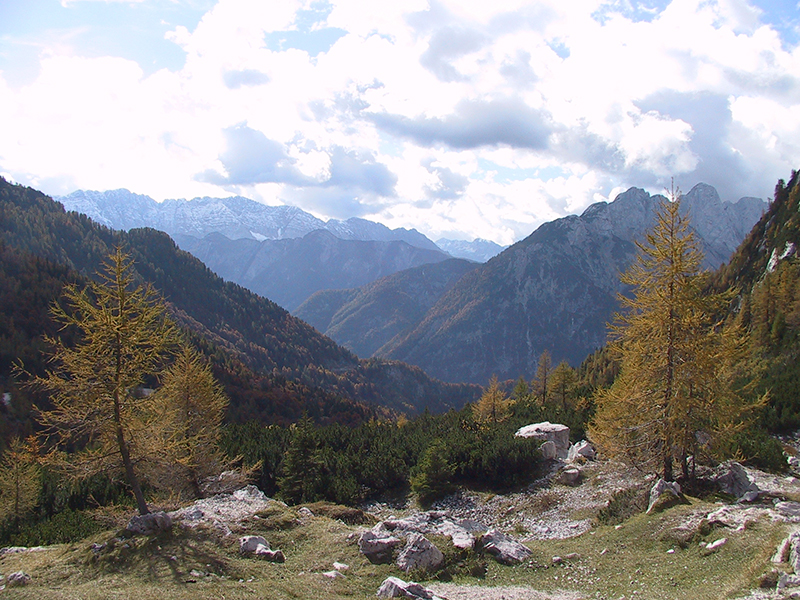
Triglav, Slovenia (photo recharge.green )
Low-consumption buildings, revamp of the regional economy, and environmental benefits: all thanks to wood. A review on European projects on energy efficiency carried out by Slovenia
Energy-efficient houses using alpine biomass – creating self-sufficient homes throughout Slovenia's Alpine region, is one of the projects of the country's current development plan. But how do you invest on renewable energy in a rigid climate?
In fact, the entire Alpine region has a great potential in terms of renewable energy. Thanks to recharge.green , a project co-financed by the European Regional Development Fund in the framework of the Alpine Space Programme , it is now possible to build energy-efficient residential buildings using environment-friendly materials, wood biomass above all. The European project involves 15 countries, including Slovenia, and namely the Triglav National Park , the Lead Partner for the section on project "Testing and Implementation", which aims to test the models and innovative tools created to use renewable energy across the Alps and determine if the results can be transferred to other Alpine regions and ensure sustainable use of forest biomass in the long term, without affecting the biodiversity of mountain regions.
"We would like to show that it is possible to use renewable energies in the Alpine region and at the same time ensure sustainable land use, thus helping preserve the rich biodiversity and the soils of the Alps", reads the website of recharge.green.
Thanks to the results obtained by this project and the collaboration of all parties involved, including Italy, it will be possible to raise awareness among politicians, government officials, NGOs, and energy producers on renewable energy across the Alps and enable them to make informed decisions. Slovenian partners include the Institute of Agriculture of Slovenia, the Department of Forestry and renewable forest resources, the University of Ljubljana, and the Slovenian Forest Service (Zavod za gozdove Slovenije ). The expected results will reflect a number of EU directives (such as the Renewable Energy Directive, the EU 2020 strategy, the Habitat and Birds Directives, and various strategies for biodiversity and soil conservation).
Energy for the house at no cost
Slovenia's goal is part of an overall strategy aimed at reducing greenhouse gas, therefore limiting global warming. Zero-energy houses are actually a necessity, since the very buildings in which we live release most of CO2 into the atmosphere and are the leading cause of climate change. The rooms in which we live and work are responsible for nearly 40% of the overall energy consumption. For this reason, the EU Directive 2010/31/UE on energy efficiency in the building sector requires that by 2020 all new buildings (2018 for public buildings) meet the standards of "nearly zero energy buildings", i.e. they consume as much energy as they are able to produce through renewable resources. The aim is to improve the energy performance of buildings, leaving it to the Member States to define the most appropriate way.
For this reason, in 2009 the European Commission launched the online portal BUILD UP , in order to motivate member countries in achieving the goals set by the EPBD (Energy Performance of Buildings Directive), sharing best practices, experiences, and knowledge in this sector. The portal, aimed at home-owners, tenants, professionals, organisations, and public authorities, provides information on legislation and energy saving as well as an updated overview of the situation in the construction sector in each country, including Slovenia.
Wood to save the climate
Thanks to the Slovenian representatives of CIPRA (International Commission for the Protection of the Alps, with international headquarters in Liechtenstein), an information campaign – Climalp – was launched in 2005 across the Alps in order to spread awareness that low-consumption buildings, built with green materials – primarily wood – protect the climate, set in motion the regional economy, and provide comfort as well as environmental benefits. The campaign received excellent feedback and has contributed to climate protection, sustainable development of the Alpine region, and the implementation of the Alpine Convention and its "Mountain forests" and "Energy" protocols. Several communities in the Alps have decided to become self-sufficient and consume energy from local renewable sources. The production of energy could be extended to local transport networks as well.
An additional contribution comes from the MountEE initiative , a project funded by the IEE European programme and by the International Charitable Foundation, which supports the mountainous regions of Scandinavia, the Alps, and the Pyrenees in changing construction and renovation practices to aim at greater energy efficiency and sustainability, with particular focus on public buildings and social housing. MountEE pursues a participatory approach and aims to involve stakeholders.
Meanwhile, Slovenia is becoming closer and closer to the target it set within the "Europe 2020" EU strategy. By that year, the country is expected to obtain 25% of the total gross energy consumption from renewable sources. In 2012 – the latest available data – the percentage was 20,2%, with a 4.1% variation compared to 2005. According to Eurostat, 60.5% of the energy produced internally from renewable sources in Slovenia comes from biomass; 33.8% from water; 3.3% from geothermal; 2.4% from solar, while there are no wind farms in the country.
















 To Top
To Top